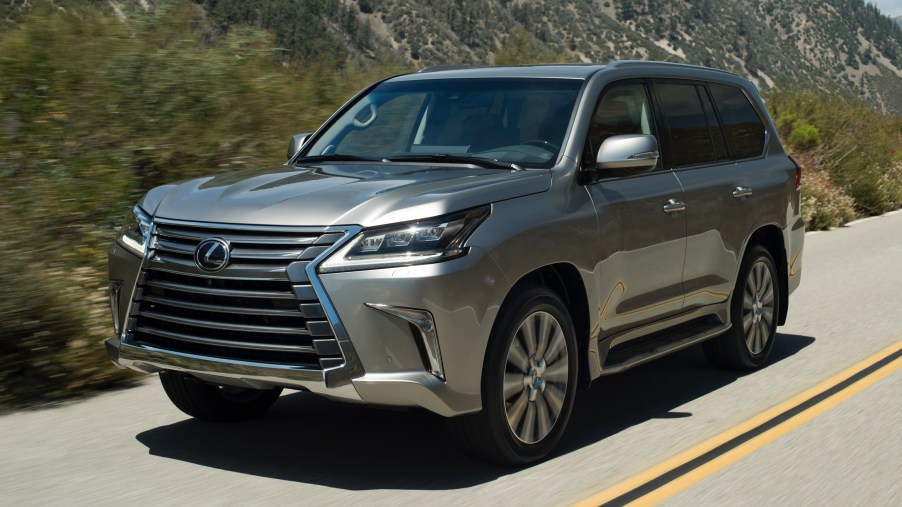
The Lexus LX 570 Is Not Worth $95,000
Looking for a large, luxurious off-road SUV. On paper, this description fits the 2019 Lexus LX 570 well enough. But, at over $90,000, does Lexus’s flagship SUV offer enough to justify its price? Doug DeMuro doesn’t think so, as he explains in the video below.
From its inception in 1996 as the LX 450, this SUV is, at its core, is a Toyota Land Cruiser. Although they look different enough from the outside, the LX and the Land Cruiser share a platform and a 5.7-liter V8 engine that makes 380 hp and 400 lb-ft of torque. It’s here that DeMuro starts to give the LX a hard look: its poor fuel economy, with 13 mpg city and 18 mpg highway, makes it one of the worst among SUVs in its class. By comparison, the new Lincoln Navigator offers 12 mpg city/23 mpg highway, with an engine that makes an additional 70 hp and 100 lb-ft of torque.
LX570 Styling
Another strike against the LX 570 is that its last update occurred in 2008, with just a few mild facelifts since then. Many of the car’s drawbacks, DeMuro notes, are tied to this lack of updates. Among the automaker’s stable of five SUVs, it seems that its ultimate one has been neglected.
And while not everyone loves Lexus’s current design language, the LX is truly a victim of unneeded styling. A significant part of the problem is the SUV’s oversized, clunky grille. Since 2008, the LX’s grille has gradually grown distractingly larger and more unsightly. Very small fog lights with enormous angular housings make the grille seem even more enormous.
Luxury-ish Interior
DeMuro seems a bit happier with the inside of the LX, which hasn’t been updated since 2008, yet seems to have stayed current. The appealing cabin has aniline leather seats and African rosewood trim. It is a luxury SUV, after all.
But the tech in this Lexus, DeMuro points out, is outdated compared to competitors such as the Audi Q7 and the Infiniti QX80. Not to mention the Mercedes-Benz GLS. For example, the Audi has a large screen for the gauge cluster that can be configured. The LX, by contrast, has a small screen that displays only a compass.
The infotainment system is also limited in large part because it’s not a touchscreen. Instead, the user is forced to use the remote touch interface controller. It’s difficult to find a location on the map and the system’s response is generally slow and clumsy. The infotainment screen for the second-row seats, located on the back of the front seats, have the same problem. Overall, DeMuro feels that this system comes up short compared to the LX’s competitors.
The center console is another antiquated component of the LX’s interior. The gear selector is bulky, whereas rivals have sleek push buttons. Cupholders are too small and are crammed into a corner, blocking access to the climate control buttons. A wireless phone charger is hidden behind a door and is, as a result, easy to overlook. But a unique and perhaps redeeming feature of the center console is a storage box that keeps food cool.
Moving further back in the vehicle, second-row seats are power-operated and have their own climate control. These are unusual features in a luxury SUV. But there is no panoramic sunroof, which DeMuro finds hard to fathom for the LX’s price point.
The third-row seats are easy to access because the second-row seats can be moved forward. But the legroom in this row is limited compared even to smaller rival SUVs because all of the LX’s off-road components are located underneath.
Another downside is found at the rear of the SUV, where only the top part of the LX’s tailgate is powered. Compare this to the Range Rover, for example, where both parts of the tailgate are power-operated. And the cargo room is less than expected for an SUV of this size due to the third-row seats folding against the rear windows.
Off-Road Capability
Driving the LX, DeMuro notes that it has an old-fashioned ride—buoyant, insubstantial, and somewhat unstable. He does like the driver’s position which sits very high and is an advantage for visibility. The vehicle has a more comfortable ride but is not quite as quiet as its rivals.
The transmission isn’t very responsive, and the SUV’s sport mode is almost non-existent. Despite these disadvantages, the LX is a respectable off-roader, which accounts in some part for its excellent resale value.
His biggest disappointment is that the LX doesn’t compare with its corporate cousin, the Land Cruiser. He drove the Toyota last year and loved it. Since it is rumored to be discontinued in the near future, he thought that the LX would be a reasonable substitute. But it falls far short.
Given how competitive the luxury SUV segment is, DeMuro takes issue with the LX being so outdated for its lofty sales price. The advantages of this car are Lexus’ customer service, the resale value, and its reliability—which are what all Lexuses have. But contemporary luxury SUVs from the Mercedes G-Wagen to the Cadillac Escalade are more up-to-date, from their engines to their tech and styling.
If buyers in this market segment have upwards of $90,000 to spend on a vehicle, they should get state-of-the-art value for their money. By failing to update the LX 570 enough to keep up with its competitors, Lexus can’t offer that kind of value. The carmaker has missed its chance to bring the SUV into the 2010s, never mind the 2020s.


